|
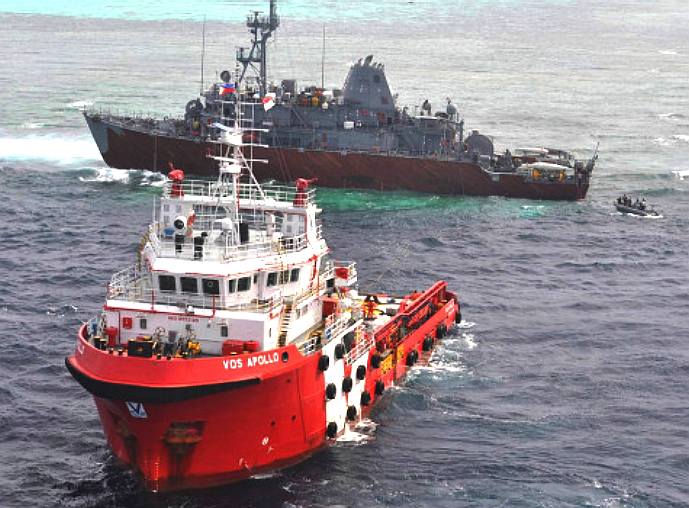
Tubattaha
Reef, Philippines - USS Guardian is shipwrecked, attended by the Vos
Apollo, Malaysian tug.
JANUARY
17 2013
A US Navy minesweeper has run aground in a protected marine sanctuary in the Philippines, the US embassy in Manila said.
The USS Guardian ran aground on the Tubattaha Reef on Wednesday night "during normal transit", it said. The extent of the damage to the ship and the cause of the accident was still not
known.
"The government of the Philippines was promptly informed of the incident and offered to assist the US
Navy."
The US Navy said on its website that the 224-foot (68-metre) vessel is based in Sasebo, southern Japan but it was not known what the ship was doing in the area when the incident happened.
Located in the Sulu Sea about 130 kilometres (80 miles) southeast of the western island of Palawan, Tubattaha Reef is a protected sanctuary that is popular with divers.
It has walls of corals, and a very diverse ecosystem that environmentalists say rivals that of the Great Barrier Reef in Australia.
The US embassy statement did not say whether any coral was damaged, although it said there were no immediate reports of fuel or oil leaks.
All its crew members were also safe, it added. The Philippine military also confirmed the grounding Thursday, but it was too early to say whether coral was damaged.
"The most probable cause is mis-navigation," Major Oliver Banaria, a military spokesman in Palawan
is quoted as saying.
Washington considers the Philippines a major non-NATO ally in Asia. It played host to some of the US military's biggest bases in Asia until 1992, when the last troops pulled out after the Senate voted to end lease agreements.
Manila ratified a visiting forces agreement with the United States seven years later, paving the way for large-scale joint military exercises.
Some 600 US forces have been operating in the southern Philippines since 2002 to train local troops against Al Qaeda-linked militants.
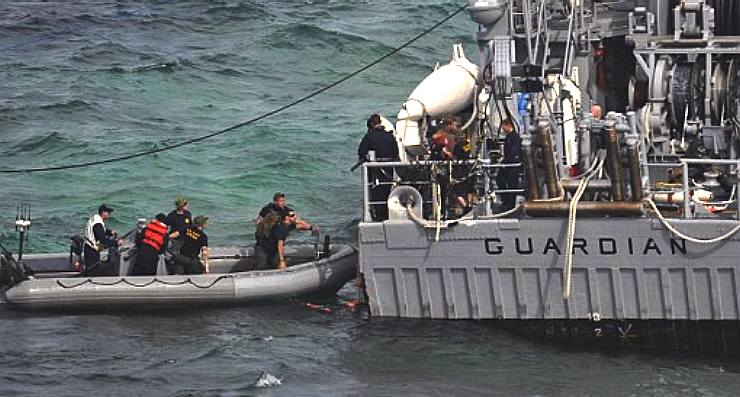
Crew
of the USS Guardian frantically unload equipment and potential
pollutants
JANUARY
30 DAILY MAIL
The U.S. Navy will hack apart a minesweeper ship worth
$277 million that is caught on a coral reef in the Philippines - rather than risk further damage to the sensitive ecosystem.
The USS Guardian has become a political and logistical nightmare for the Navy since it ran aground on January 17 in the Sulu Sea.
Navy engineers decided their only option is to destroy the 225-foot ship by cutting it up and hauling it away on a barge, instead of trying to drag it off the reef.
The vessel, which would cost $277million to replace, is 23 years old and one of just 14 of her type in the Navy.
It was on its way from Subic Bay, Philippines, to its next port call in Indonesia when it struck the reef, about 80 miles (130 kilometers) east-southeast of Palawan Island in the Sulu Sea.
Attempts to free the Avenger-class mine countermeasures ship at high tide were unsuccessful. Its crew was evacuated to other vessels, and the ship was battered by waves that pushed it farther onto the reef.
The Philippine government is furious over the damage to the Tubbataha Reef, which is a national park and a UNESCO World Heritage site. The government has demanded that the U.S. Navy do as much as possible to minimize damage to the coral.
'Tubbataha Reef is a treasure to the Philippine people, we absolutely understand her environmental importance,' Lieutenant Anthony Falvo, a spokesman for the Navy's Pacific Fleet, told
MailOnline. Additionally, engineers worry that the ship - which has a wood and fiberglass bottom - might no longer be seaworthy after its hull was punctured by the coral.
It's unclear how, exactly, the ship will be dismantled - it's something that the Navy has not done in recent memory - or perhaps ever, experts say.
The Navy has contracted two massive crane ships and a barge from the Dutch contractor Smit International to clean up and remove the Navy vessel.
So far the vessel's tanks have been pumped full of seawater to keep the vessel stable while salvage ships make their way to the location.
Navy-led salvage teams have already removed most of the ship's materials that could be environmentally harmful to Tubbataha Reef.
These materials include paint, solvents and lubricants, according to a statement from the U.S. Embassy in Manila.
All of the 15,000 gallons of diesel fuel aboard the 224-foot-long, 1,312-ton ship were removed Friday, along with dry food stores and the personal effects of the Guardian's crew of 79, the Navy
is quoted as saying. Experts have also started to reinforce the wood-and-fiberglass hull of the minesweeper with Kevlar to limit stresses from waves hitting the vessel, the U.S. Embassy said.
The $61 million vessel was on its way from Subic Bay, Philippines, to its next port call in Indonesia when it struck the reef, about 80 miles (130 kilometers) east-southeast of Palawan Island in the Sulu Sea.
Initial efforts to free the Avenger-class mine countermeasures ship at high tide were unsuccessful. Its crew was evacuated to other vessels, and the ship was battered by waves that pushed it farther onto the reef.
An investigation is under way to determine the cause of the grounding. A Navy spokesman, Lt. Cmdr. James Stockman,
is quoted as saying that the U.S. National Geospatial-Intelligence Agency, which prepares the digital navigation charts used by the Navy, has reported the location of the reef was misplaced on a chart by nine miles.
The Tubbataha Reef is home to a vast array of sea, air and land creatures, as well as sizable lagoons and two coral islands. About 500 species of fish and 350 species of coral can be found there, as can whales, dolphins, sharks, turtles and breeding seabirds, according to UNESCO.
Philippine officials said this week that the Philippines would seek compensation for damage to the reef. About 1,000 square meters (about 10,760 square feet) of the reef have been damaged.
The Navy is still investigating how the ship, which is designed to seek and destroy marine
mines, ran aground.
The ship has complex sonar systems that can detect mines beneath the surface of the water. It is unknown how the systems failed to detect the reef.
The Navy has said its maps placed the Tubbataha Reef eight nautical miles off from its actual location.
Lieutenant Commander Mark Rice was in charge of the of the ship when she hit the reef as she was sailing between Puerto Princesa and Indonesia on a routine patrol.
None of the 79 sailors about the ship were injured and all but ten of the crew was returned to the
forward deployment base in Sasebo, Japan. Those ten sailors, including Lt Commander Rice, remained behind aboard the USS Mustin - a guided missile destroyer that is overseeing the cleanup operation.
Lt Falvo said the Navy would determine whether Lt Commander Rice will face disciplinary action after it concludes its investigation of the crash.
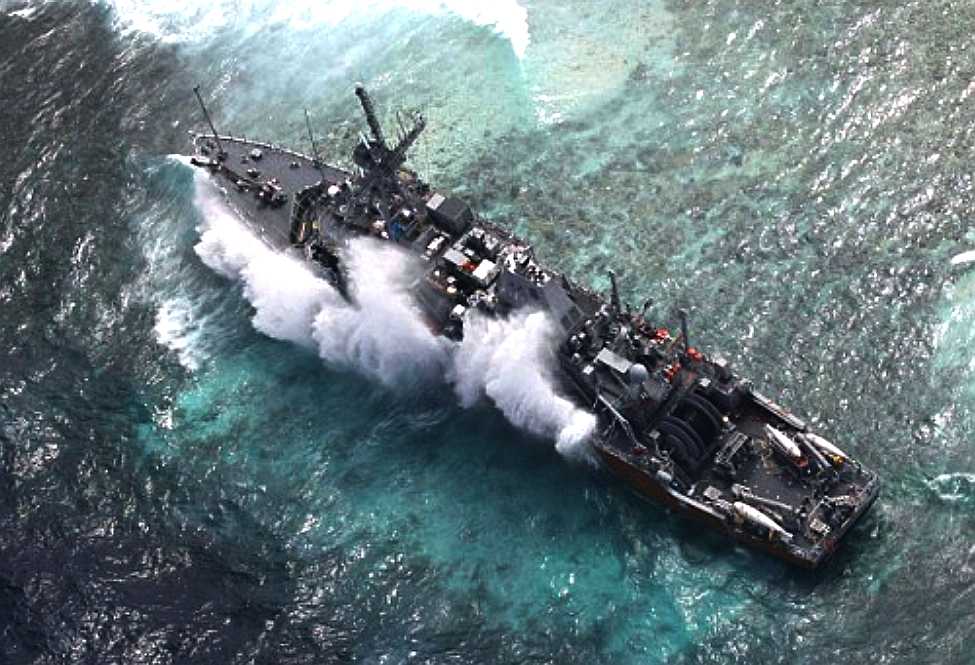
Tubattaha
Reef, Philippines - USS Guardian is stuck fast and battered by waves
MARCH
27 2013 CNN
The bow of a U.S. Navy warship that grounded on a Philippine reef in January was cut from the rest of the hull on Tuesday, lifted by a massive crane and dropped on a waiting barge.
"The bow section of the USS Guardian was lifted out of the water around 2:45 p.m.," said Enrico Efren Evangelista, head of the Philippine coast guard Palawan District, according to the official Philippine News Agency.
"The lifting of the first large hull section was a significant accomplishment. Each of these sections weigh about 250 tons," Capt. Mark Matthews, supervisor of the salvage operation, said in a U.S. Navy 7th Fleet blog post. The hull will be removed in four sections, the Navy said.
"Preparing the ship for this sectioning has been extremely challenging. We have had to painstakingly clear about a two-foot path inside the ship, removing everything that is in our way," Matthews said. "Once the path is clear, the hull cutting is done manually by Navy divers and salvage contractors using chainsaws and reciprocating saws, and some of this cutting is underwater using hydraulically driven tools."
The removal of the bow of the U.S. Navy minesweeper was followed by that of the ship's auxiliary engine room, a 200-ton piece that was removed Wednesday afternoon.
With the removal of the two sections, about 900 tons of the formerly 1,312-ton warship remain on Tubbataha Reef, the news agency reported.
The U.S. Navy expects the Guardian to be completely removed from the reef by the second week of April, Evangelista said.
It was decommissioned and stricken from the naval registry on February 15.
The minesweeper ran onto the reef on January 17. An investigation into the grounding is ongoing, but Navy officials said in January that the U.S. National Geospatial-Intelligence Agency, which prepares the digital navigation charts used by the Navy, has reported the location of the reef was misplaced on a chart by nine miles.
Tubbataha Reef, a UNESCO World Heritage Site, is home to about 500 species of fish, 350 species of coral as well as whales, dolphins, sharks, turtles and breeding seabirds, according to UNESCO.
The Guardian is estimated to have damaged about 4,000 square meters (about 43,000 square feet) of the reef. The Navy has pledged to clean up the debris created when waves stripped off pieces of fiberglass covering the wooden hull of the ship and to try to restore the reef as much as possible.
Philippine officials said that the country would seek compensation for reef damage. Harry K. Thomas Jr., the U.S. ambassador to the Philippines, has assured Filipinos that the United States "will provide appropriate compensation for damage to the reef caused by the ship."
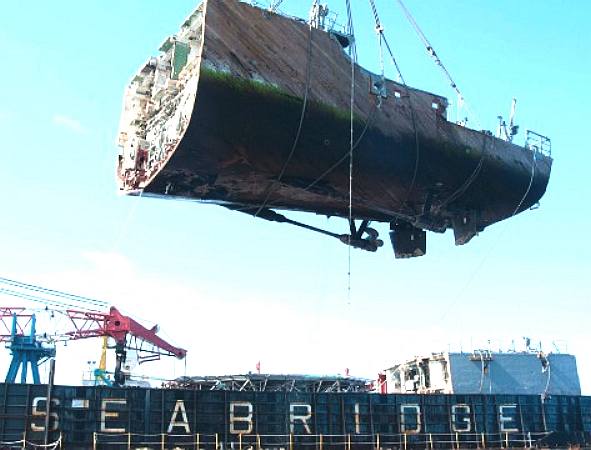
Tubattaha
Reef, Philippines - USS Guardian - last quarter of hull is removed by
crane ship
MARCH
30 2013 CNN
The Guardian is gone. What was left of the former U.S. Navy minesweeper was lifted off a Philippine reef on Saturday.
"The stern was lifted around 1:50 p.m.," Philippine Coast Guard Palawan District head Commodore Enrico Efren Evangelista told the state-run Philippine News Agency.
It was the last of the four sections of the wood and fiberglass hull the USS Guardian had been cut into in the effort to remove it from where it ran aground on January 17.
The 250-ton stern segment was placed aboard a waiting barge.
"As the hull has been removed, the team is now shifting their effort to collecting minor debris that remains on the reef," the head of the salvage operation, Navy Capt. Mark Matthews, said in a statement.
"We also have a collaborative team from the U.S. and the Philippines beginning to assess the condition of the reef."
The Guardian is estimated to have damaged about 4,000 square meters (about 43,000 square feet) of the reef, a UNESCO World Heritage site that is home to about 500 species of fish and 350 species of coral, as well as whales, dolphins, sharks, turtles and breeding seabirds.
The Navy has pledged to clean up the debris created when waves stripped off pieces of fiberglass covering the wooden hull of the ship and to try to restore the reef as much as possible.
"(With this complete) the second phase which is the assessment and recovery phase (for the damaged reef) begins," Evangelista said.
"Every salvage operation presents unique challenges. It has been difficult to extract the Guardian without causing further damage to the reef, but the U.S. Navy and SMIT salvage team with support from other companies and the government of the Philippines have really done a superb job. I could not be more proud," Matthews said. "We continue to work closely with the Philippine Coast Guard, Navy and Tubbataha Reef Park Rangers, and we are grateful for the support we have received to remove Guardian and minimize further damage to the reef."
An investigation into the grounding is ongoing, but Navy officials said in January that the U.S. National Geospatial-Intelligence Agency, which prepares the digital navigation charts used by the Navy, has reported the location of the reef was misplaced on a chart by nine miles.
While the removal of the stern from the reef may visually mark the end of the Guardian, the ship was officially stricken from the U.S. Navy registry in February. Navy communications now refer to it as the Ex-Guardian. It has been replaced in the Pacific by the USS Warrior, which arrived at the U.S. naval base in Sasebo, Japan, earlier this month. The Guardian's crew will take over operation of the Warrior.
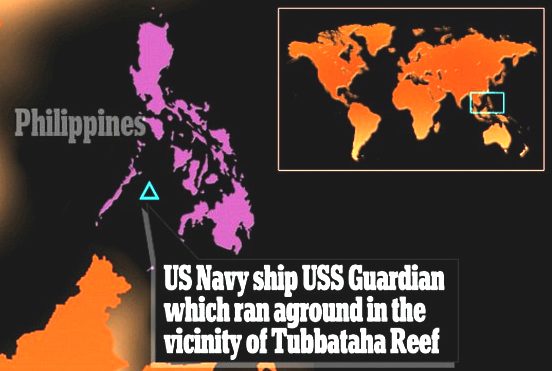
Location
map of the Tubattaha
Reef, Philippines and USS Guardian shipwreck
LINKS
Daily
Mail US Navy hack $61million minesweeper ship -pieces -remove sensitive
reef Philippines http://edition.cnn.com/2013/03/27/world/asia/us-navy-ship-aground/index.html
http://edition.cnn.com/2013/03/30/world/us-navy-ship-reef
US
Department of Navy Research, development & Acquisition - http://acquisition.navy.mil/ US
Fleet Forces Command - http://www.cffc.navy.mil/
US
http://www.msc.navy.mil/
http://en.wikipedia.org/wiki/Naval_Oceanographic_Office
http://www.maritimejournal.com/news101/industry-news/ukho-appoints-new-national-hydrographer http://en.wikipedia.org/wiki/United_Kingdom_Hydrographic_Office http://www.ths.org.uk http://www.spri.cam.ac.uk/friends/committee/ http://www.thefutureofnavigation.com/ten_steps.aspx http://www.quaynote.com/ankiti/www/?code=ecdis13&f=programme
Wiki
United_Kingdom_Hydrographic_Office
UKHO
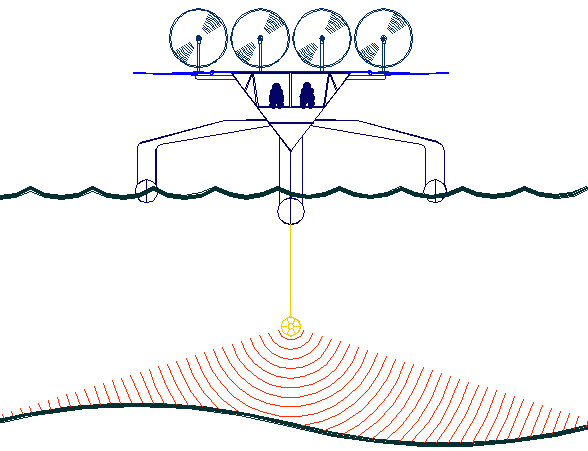
The
key to accurate hydrographic mapping is continuous monitoring,
for which the Bluefish SNAV
platform, presently under development, is a robotic ocean workhorse. Based on a stable
SWASH
hull this design is under development in the UK, looking to expand into
the US. The robot
ship uses no diesel fuel to monitor the oceans autonomously (COLREGS
compliant) at relatively high
speed 24/7 and 365 days a year - only possible with the revolutionary (patent) energy harvesting system. The
hullform is ideal for automatic release and recovery of ROVs
or towed arrays, alternating between drone and fully autonomous modes. This
zero carbon vessel
pays for itself in fuel saved every ten years. It may be built under
Licence including technology transfer.
|





